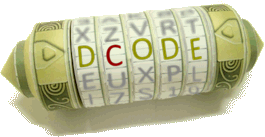Tool/Calculator to find missing number/fill the blanks puzzles/equations (addition, subtraction, multiplication, division)
Missing Numbers Calculator - dCode
Tag(s) : Number Games, Arithmetics
dCode is free and its tools are a valuable help in games, maths, geocaching, puzzles and problems to solve every day!
A suggestion ? a feedback ? a bug ? an idea ? Write to dCode!
Missing Numbers Calculator
Find the Missing Digits Solver
Find x in an Equation Solver
Answers to Questions (FAQ)
What is a calculation with blanks? (Definition)
A calculation with blanks (such as an addition, a subtraction, a multiplication, or a division) is a math exercise that involves finding the missing numbers and digits.
There is a variant where the operators (+ - * /) are missing.
How to solve a calculation with blanks?
Solving a calculation with operators and missing digits is similar to a cryptarithm and uses deduction and extraction of parts of the calculation.
Example: Exercise: find ? in the operation ??5 + 42? = 539 => 115 + 424 = 539
Example: 12 + 23 = ? has no solution but 12 + 23 = ?? has for solution 12 + 23 = 35
It is useful to calculate digits at extremities, or check individually calculations to the ten digits, or the hundreds digit etc.
dCode also has a cryptarithm solver (where blanks are letters), a mathematical equation solver or even a countdown game calculator tool.
How does the missing numbers solver works?
dCode solver allow usual operators like additions +, subtractions -, multiplications * and divisions /. It also handles comparison operators superior and inferior > and < in addition to the equal sign =.
The blanks (unknown digits) have to be replaced by ? (interrogation marks). There is no limit but above 7 or 8, the calculation will be very long.
Example: 1+?=3 is solved with 1+2=3
Example: 2*?=8 is solved with 2*4=8
This solver uses a brute-force method, this means that it tries all combinations and display the possible ones.
Why is no solution found?
If the message 0 solution(s) is displayed, it is impossible to replace the ? by numbers so that the calculation is valid. Several explanations:
— the ? is a number (consisting of several digits)
Example: 5+?=23 has no solution, but 5+??=23 does have the solution 18
— the ? is a negative number
Example: 5+?=1 has no solution but 5+-?=1 has a solution of 4
— an error may be in the problem statement
Why do gap calculations?
Fill in the blanks puzzles can help users improve their math skills. By solving these calculations, users can improve their understanding of basic math rules and improve their solving speed.
Why should floating point numbers be avoided?
Point calculations sometimes cause problems due to the way languages handle floating point numbers. The IEEE 754 standard uses a binary representation to store floating point numbers, but it cannot store all floating point numbers exactly. Therefore, when a floating point number is stored, there may be a small loss of precision. This loss of precision can lead to miscalculations when floating point numbers are used in complex mathematical calculations.
Source code
dCode retains ownership of the "Missing Numbers Calculator" source code. Any algorithm for the "Missing Numbers Calculator" algorithm, applet or snippet or script (converter, solver, encryption / decryption, encoding / decoding, ciphering / deciphering, breaker, translator), or any "Missing Numbers Calculator" functions (calculate, convert, solve, decrypt / encrypt, decipher / cipher, decode / encode, translate) written in any informatic language (Python, Java, PHP, C#, Javascript, Matlab, etc.) or any database download or API access for "Missing Numbers Calculator" or any other element are not public (except explicit open source licence like Creative Commons). Same with the download for offline use on PC, mobile, tablet, iPhone or Android app.
Reminder: dCode is an educational and teaching resource, accessible online for free and for everyone.
Cite dCode
The content of the page "Missing Numbers Calculator" and its results may be freely copied and reused, including for commercial purposes, provided that dCode.fr is cited as the source.
Exporting the results is free and can be done simply by clicking on the export icons ⤓ (.csv or .txt format) or ⧉ (copy and paste).
To cite dCode.fr on another website, use the link:
In a scientific article or book, the recommended bibliographic citation is: Missing Numbers Calculator on dCode.fr [online website], retrieved on 2025-04-16,
